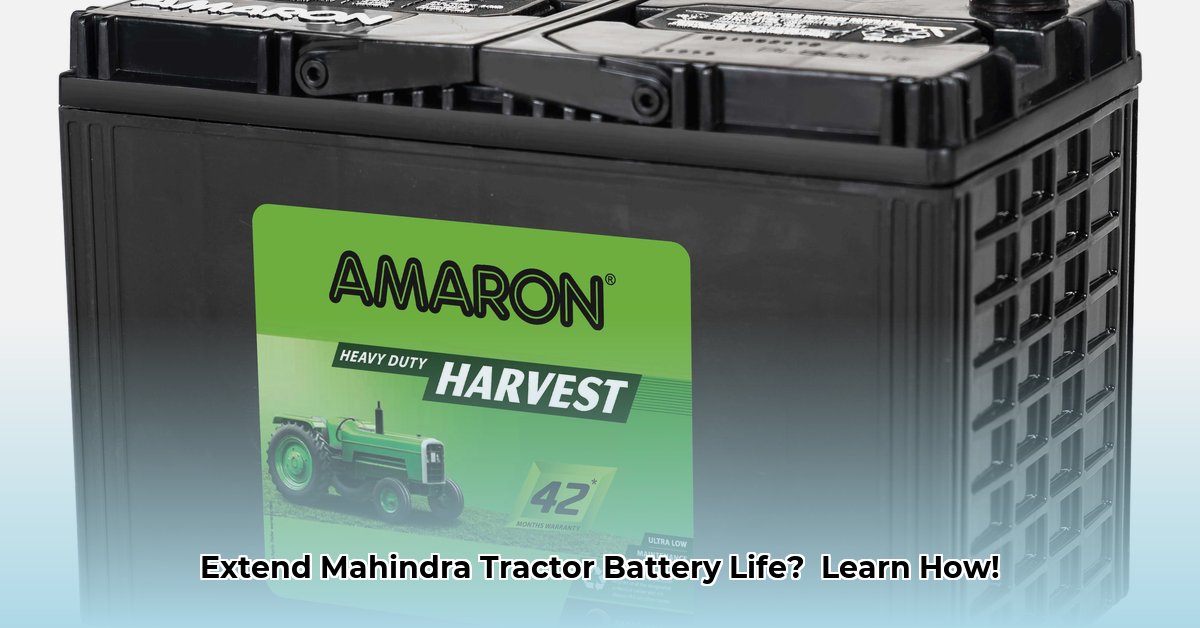
Understanding Your Mahindra Tractor Battery: The Powerhouse of Your Farm
Your Mahindra tractor's battery is its heart—essential for starting the engine and powering accessories. A healthy battery ensures smooth operation and prevents costly downtime. But what kind of battery do you have? Most Mahindra tractors utilize lead-acid batteries (a rechargeable battery using lead plates in an electrolyte solution), readily available and relatively easy to maintain. Understanding your specific battery type (check your owner's manual!) is the first step toward maximizing its lifespan. This knowledge helps you choose the right maintenance techniques and replacement battery. For more info on replacement batteries, check out this helpful resource: Lawn Tractor Batteries.
A Simple, Effective Maintenance Plan: Your Tractor's Battery Checkup
Regular maintenance is key to a long-lasting battery. This simple plan, performed monthly or after periods of heavy use, can significantly extend your battery's life:
Visual Inspection: Check for corrosion (white, crusty buildup on terminals), loose connections, cracks in the battery case, or any signs of damage.
Terminal Cleaning: Corrosion restricts power flow. Gently clean terminals using a wire brush and a baking soda paste (baking soda mixed with water). Remember always disconnect the negative terminal first!
Connection Tightening: Ensure all battery clamps are securely fastened. Loose connections are a common cause of battery failure.
Battery Cleaning: Wipe the entire battery top with a damp cloth to remove dust and dirt. This prevents moisture buildup.
Electrolyte Level Check (Flooded Batteries Only): If your battery is a flooded lead-acid type (check your owner's manual), check the electrolyte level. Add distilled water only if necessary, following your owner's manual's instructions precisely.
Charging (If Necessary): If your tractor is slow to start, charge the battery using a charger appropriate for its size and type. Always follow the charger's instructions carefully.
Choosing a Replacement Battery: Factors to Consider
When it's time for a new battery, these factors are crucial for selecting the right one:
Cold Cranking Amps (CCA): This rating indicates the battery's ability to deliver power in cold temperatures. Higher CCA is better for cold climates.
Reserve Capacity (RC): This specifies how long the battery can power accessories (headlights, etc.) with the engine off. A higher RC is preferable.
Battery Brand: Research reputable brands known for durability and reliability. This is an investment in your operation's uptime.
Cost vs. Lifespan: While premium batteries are initially more expensive, their longer lifespan often translates to long-term cost savings.
Seasonal Battery Care: Protecting Your Investment
Proper off-season storage significantly extends battery life:
Full Charge: Store the battery fully charged to prevent deterioration during inactivity.
Clean & Dry Storage: Keep the battery in a clean, dry location, away from excessive moisture.
Temperature Control: Avoid extreme temperatures (both hot and cold). Ideal storage is a cool, dry space, possibly climate-controlled.
Battery Maintainer: A battery maintainer (a device that keeps the battery topped off) is a worthwhile investment for long-term storage.
Troubleshooting Common Battery Problems: Quick Fixes & Professional Help
Slow Starting: This often indicates a weak battery or loose connections. Check connections, and then test the battery’s voltage yourself or at an auto parts store.
No Start: Check connections, then have a professional test the battery to determine if it requires replacement.
Unexpected Battery Drain ("Parasitic Drain"): A parasitic drain (an electrical draw while the tractor is off) requires professional diagnosis.
Extending Mahindra Tractor Battery Life Sustainably: Best Practices
Key Takeaways:
- Regular maintenance is crucial for maximizing battery lifespan and minimizing environmental waste.
- Simple checks prevent costly repairs and extend uptime.
- Sustainable practices help reduce the environmental impact of battery disposal.
Three Pivotal Points for Sustainable Battery Life:
- Regular cleaning: Removing corrosion ensures optimal electrical connection.
- Voltage monitoring: Detecting charging system issues early prevents battery damage.
- Responsible disposal: Properly recycling old batteries minimizes environmental harm.
Remember, proactive battery maintenance is an investment in your farm's productivity and long-term success. Regular inspections, cleaning, and timely replacement ensure your Mahindra tractor stays running smoothly, year after year.